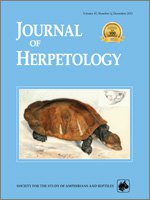Resistance to cutaneous evaporative water loss has been examined in anuran amphibians that occupy a variety of habitats, except for the ocean. We measured evaporative water loss rate and cutaneous resistance to evaporation in the Crab-eating Frog, Fejervarya cancrivora, a euryhaline species that enters the sea. Studies were conducted on Hoga Island, southeastern Sulawesi, Indonesia. Area-specific evaporative water loss rate was significantly lower in living F. cancrivora than in agar replicas of the frogs and total water loss rate was dependent on body mass. Cutaneous resistance to evaporative water loss was 0.27 sec cm−1, which is the lowest significant resistance known for frogs. Cutaneous resistance may have evolved as a way for F. cancrivora to reduce water loss while on land, thereby offsetting high osmotic losses to seawater before frogs have fully acclimated to higher salinities.
How to translate text using browser tools
1 December 2011
Cutaneous Resistance to Evaporative Water Loss in the Crab-eating Frog (Fejervarya cancrivora)
Mark L. Wygoda,
Theresa F. Dabruzzi,
Wayne A. Bennett
ACCESS THE FULL ARTICLE

Journal of Herpetology
Vol. 45 • No. 4
December 2011
Vol. 45 • No. 4
December 2011




